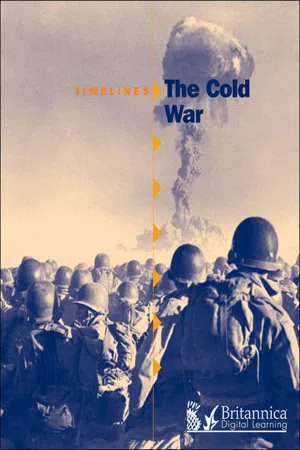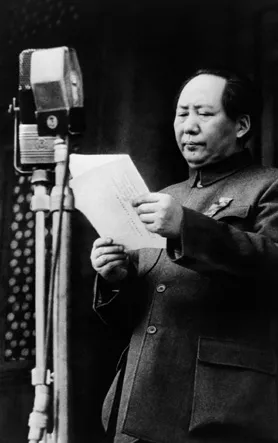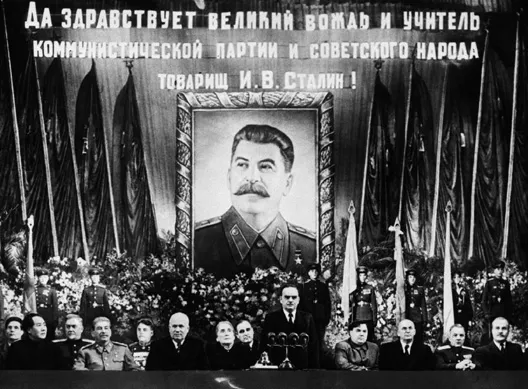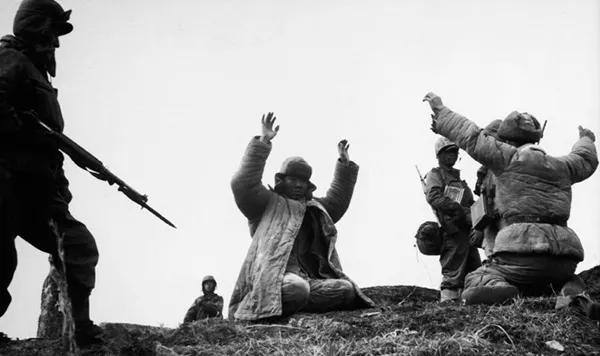
- English
- ePUB (mobile friendly)
- Available on iOS & Android
eBook - ePub
The Cold War
About this book
In The Cold War, significant events that helped shape the Cold War are explored, including: the first H-bomb test; the Vietnam War; the Soviet invasion of Afghanistan; and the fall of the Berlin Wall.
Frequently asked questions
Yes, you can cancel anytime from the Subscription tab in your account settings on the Perlego website. Your subscription will stay active until the end of your current billing period. Learn how to cancel your subscription.
At the moment all of our mobile-responsive ePub books are available to download via the app. Most of our PDFs are also available to download and we're working on making the final remaining ones downloadable now. Learn more here.
Perlego offers two plans: Essential and Complete
- Essential is ideal for learners and professionals who enjoy exploring a wide range of subjects. Access the Essential Library with 800,000+ trusted titles and best-sellers across business, personal growth, and the humanities. Includes unlimited reading time and Standard Read Aloud voice.
- Complete: Perfect for advanced learners and researchers needing full, unrestricted access. Unlock 1.4M+ books across hundreds of subjects, including academic and specialized titles. The Complete Plan also includes advanced features like Premium Read Aloud and Research Assistant.
We are an online textbook subscription service, where you can get access to an entire online library for less than the price of a single book per month. With over 1 million books across 1000+ topics, we’ve got you covered! Learn more here.
Look out for the read-aloud symbol on your next book to see if you can listen to it. The read-aloud tool reads text aloud for you, highlighting the text as it is being read. You can pause it, speed it up and slow it down. Learn more here.
Yes! You can use the Perlego app on both iOS or Android devices to read anytime, anywhere — even offline. Perfect for commutes or when you’re on the go.
Please note we cannot support devices running on iOS 13 and Android 7 or earlier. Learn more about using the app.
Please note we cannot support devices running on iOS 13 and Android 7 or earlier. Learn more about using the app.
Yes, you can access The Cold War by Reg Grant, Britannica Digital Learning in PDF and/or ePUB format, as well as other popular books in Política y relaciones internacionales & Historia del siglo XX. We have over one million books available in our catalogue for you to explore.
Information
Communists Take Power in China
1 OCTOBER 1949
The civil war between the Nationalist government of China, headed by Chiang Kai-shek, and Chinese Communist guerrillas, led by Mao Zedong, began in 1927. When Japan invaded China in 1937, the Nationalists and Communists formed an alliance against the invaders. However, after the Japanese surrendered in August 1945, defeated by the Allies, the civil war in China soon resumed.
The Soviet Union, which occupied Manchuria in northern China at the end of World War II, helped the Chinese Communists establish a strong position there. But Stalin did not encourage Mao to try to take power in China, suggesting instead that he reach an agreement with Chiang Kai-shek. The U.S., while supplying the Nationalists with money and arms, also tried to push the two sides into making a compromise agreement. A ceasefire arranged by the Americans in January 1946 soon broke down, however, and the scale of the fighting continued to grow.
The Chinese Communists succeeded in winning a great deal of popular support in rural areas they controlled, through a reform programme that gave land to peasants. The Nationalists, by contrast, were notoriously corrupt and failed to stop runaway inflation. Their soldiers became increasingly disillusioned and began to desert in large numbers. In the summer of 1949, Chiang took refuge with the remnants of his armies on the island of Formosa (Taiwan). The Communists occupied Beijing and Mao declared China a People’s Republic.

Mao Zedong proclaims the founding of the People’s Republic of China in Tiananmen Square on October 1, 1949.
ALLIANCE WITH STALIN
The U.S. government was not prepared to undertake the major war that would have been required to challenge Communist power in China. Instead, there were hopes that a deal could be struck with Mao, to stop China joining the Soviet bloc. But in early 1950, Mao sought an alliance with Stalin. After the outbreak of the Korean War in June 1950, the U.S. gave its support to the Nationalists in Taiwan, refusing to recognize the Chinese Communist government as the legitimate government of China. By the end of 1950, Chinese and U.S. troops were fighting in Korea.
TIMELINE |
CHINA—CIVIL WAR TO KOREAN WAR 1945–1950 |
August 8, 1945 |
Soviet troops invade Japanese-occupied Manchuria after the Soviet Union declares war on Japan. |
October 1945 |
Chinese Nationalists and Communists begin fight for control of Manchuria. |
January 10, 1946 |
Nationalists and Communists agree ceasefire under pressure from U.S. |
July 1946 |
Nationalists launch major offensive in Manchuria. |
January 10, 1949 |
Communists defeat Nationalists at Xuzhou. |
July 1949 |
Nationalists begin evacuation of forces to Formosa (Taiwan). |
October 1, 1949 |
Mao Zedong proclaims People’s Republic of China. |
February 1950 |
Mao negotiates alliance with the Soviet Union. |
June 26, 1950 |
U.S. fleet is sent to protect Nationalist-ruled Formosa from Communist China. |
October 1950 |
Communist Chinese forces enter the Korean War. |

Mao, front left, attends the celebrations for Stalin’s birthday in Moscow, April 1950.

CROSS-REFERENCE
KOREAN WAR: PAGES 12–13
NIXON MEETS MAO: PAGES 32–33
Allies of the Soviets
“[We must] ally ourselves with the Soviet Union. . . . In the epoch in which imperialism exists it is impossible for a genuine people’s revolution to win victory in any country without various forms of help from international revolutionary forces, and even if victory were won, it could not be consolidated. . . . Would the present rulers of Britain and the USA, who are imperialists, help a people’s state?”
From a speech by Mao Zedong on the “People’s Democratic Dictatorship,” June 30, 1949.
Korean War Begins
25 JUNE 1950

Communist Chinese soldiers are taken prisoner by U.S. Marines during the Korean War.
In June 1950, Communist North Korea launched a full-scale invasion of South Korea, starting a war that would last three years and cost over 5 million lives.
NORTH–SOUTH DIVIDE
At the end of World War II, the Soviet Union and the U.S. had agreed to divide Korea into zones of military occupation, Soviet troops running the northern half and U.S. troops the south. The division was intended to be temporary but, as in Germany, the Soviets and Americans could not agree on a form of government for Korea. Instead, a pro-U.S. government was established in the south and a Soviet-backed government in the north.
When the north invaded the south on June 25, 1950, the U.S. immediately sent forces to aid South Korea, winning the backing of the United Nations (UN) for its military action. Fifteen countries, including Britain, sent troops to join the U.S.-led UN forces aiding South Korea. By the end of September 1950, UN forces had driven the North Koreans out of South Korea. The commander in Korea, General Douglas MacArthur, then launched an invasion of North Korea. Counter to instructions from the U.S. government, MacArthur advanced up to Korea’s border with Communist China. The Chinese then sent troops into North Korea to attack the UN forces and drove them back into South Korea.

TIMELINE | CONFLICT IN KOREA 1945–1953 |
August 1945 | U.S. and Soviet Union agree division of Korea into occupation zones. |
August 1948 | U.S. zone is proclaimed Republic of Korea. |
September 1948 | So... |
Table of contents
- Cover Page
- Title Page
- Copyright Page
- Contents
- Yalta Conference—February 4, 1945
- Truman Doctrine Proclaimed—March 12, 1947
- Soviets Impose Berlin Blockade—June 24, 1948
- Communists Take Power in China—October 1, 1949
- Korean War Begins—June 25, 1950
- First H-bomb Test—November 1, 1952
- Rosenbergs Executed for Espionage—June 19, 1953
- Hungarian Uprising Suppressed—November 4, 1956
- First Sputnik Launch—October 4, 1957
- U2 Spyplane Shot Down—May 1, 1960
- Berlin Wall Erected—August 17, 1961
- Kennedy Declares Naval Blockade of Cuba—October 22, 1962
- U.S. Marines Sent into Vietnam—March 8, 1965
- Soviet Invasion Ends Prague Spring—August 20, 1968
- Nixon Visits China—February 21, 1972
- U.S.-backed Coup in Chile— September11, 1973
- Apollo–Soyuz Mission—July 17, 1975
- Soviet Invasion of Afghanistan—December 24, 1979
- Polish Workers Occupy Gdansk Shipyard—August 14, 1980
- Reagan and Gorbachev Agree Arms Cuts—December 8, 1987
- Fall of Berlin Wall—November 9, 1989
- Key Figures in the Cold War
- Glossary
- Further Information
- Index